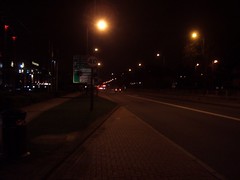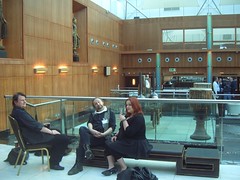Distant suburbs with names starting in H
Categories: uncategorized, circumnavigation, buildings-and-cities
Tags: cities, urbanwalks, trains, millwall, circumnavigation
Date: 18 April 2010 16:34:06
To Bedfont Lakes for a work meeting, or sales pitch. Second time I've been in the Heathrow area in a few weeks - I popped over to have a drink in the bar at the end of Eastercon (as usual I couldn't go to the con myself as its one of the busy times of year at church) That was train to Feltham, then local bus to the north side of the airport, today train to Feltham and little local bus to Bedfont.
Architecturally its still the 1960s out there in the outer western reaches of London where where placenames start with "H". If not the 1930s. As always in buildings 30 or 40 years out of date looks more dated than 300 or 400, and the Heathrow area looks very dated. OK, know a lot of the hotels and offices are newer than that but they don;t look it. Compared with the buildings you see in Inner London these look dull and unimaginitive. Air travel was once a thrill and airports were once stage-sets for the party of the future, but now they look boring. Inner London. even the parts of it full of Gearogoan or Victorian retrofits, looks much more futuristic
The most interesting buildings you can see from the Heathrow Perimeter Road are in fact the older ones that look left over from the 1940s or 50s or even before. Rows of sheds with unlikely looking corporate logos advertising some small company you have never heard of that is in to import/export, or oil exploration, or even "aviation" whatever exactly that means nowadays. Its as if the old between-the-wars civil aviation culture of small engineering firms, dodgy dealers, and mechanics tinkering with This and That that I vaguely remember in the backdrop of old films and TV programmes has somehow managed to survive in the gutters and beneath the onramps of the corporate monocultures that replaced them.
In a similar way the little 1920s bungalows in the suburbs round about, squeezed between rows of 1970s officed or 1990s blocks flats, some retrofitted into newer larger "properties", others still looking like small sheds with fake beams and tarmac sheeting rooves (but all I suspect double glazed) are more interesting than the EMEA HQs and cheap business hotels.
The whole place is caught in a sort of fast-moving limbo. Its not the network of semi-rural suburbs it once was, before the War and the motorways and above all Heathrow Airport turned it over, although it is full of survivals of that era. But its not quite the American-style low-rise decentralised suburban landscape it could have been - there is just too much naff 1950s and 1960s municipal Englishness about, a whiff of the the Council Estate, the H-Block, the Nissen Hut and the Scout Hut. The overlaid palimpsest of the 1950s, a hint of Durrington. Yes, if Woodingdean was thirty times the size, flat instead of hilly, and had a major international airport inside it, and was nowhere near the sea, it might look like this. Maybe that's why it feels like the early 1960s to me because the buildings (nothing else, just the buildings) remind me of where I spent my own early 1960s. And it hasn't gone forward to the kind of post-modern high-tech complexity that it might one day become.
From a literary-architectural point of view the Heathrow area left John Betjemen behind, bypassed JG Ballard (though he chased after it and nearly caught it) and hasn't yet arrived at Ken MacLeod.
Not too many photos from the Con I'm afraid. It was dark most of the time I was there.
I do have a few of the hotel bar though. Like most cheap/mid-price hotels, whether in suburban sheds with legoland trimmings (as this one was) or in old buildings in town it seemed to have that tedious interior design that's a sort of mixture of fake vaguely 18th century English wood-panelled massiveness and late 19th century French frippery. Flock wallpaper and cut glass, the direct descendent of the Gin Palace without the over-the-topness. Both unimaginitive and deracinated.
But the room the bar was in was much better! A sort of truncated atrium dominated by a vast garden water-feature with pastic glow-in-the-dark fish on sticks. And big Buddhist pots in piles of pebbles. OK jsut as ersatz and off-the-shelf but at least its different and most importantly it was a pleasant and easy space to be in - though I guess a lot of that was due to the lightly-arched glass roof that meant the whole room was adequateley and indireclty lit by natural light right up almost to sunset. Follow th link for more (though not better) pictures: 
The visit to Bedfont Lakes produced even fewer photos. I'll have to go back one day when I'm not working. Its a nightmare to navigate, no rationality to anything and no signage. Took us longer to find the building we were looking for once there than it did to get there from Feltham Station over a mile away. Everything assumes you are coming by car. What I should have done is follow the car road in and walk straight in ignoring the barrier that said "No Pedestrian Access", which was how I got out. As it was I ended up getting to the Cisco building by going round the back of one of the IBM buildings and past the lake. Which was pleasant. I'm sure there is another way in on foot - I can even guess where it might be - but its not signed.
These places are too planned, too centrally controlled, and have too few children visiting them. A council estate laid out like that (and the word ones are) would soon be crossed by "paths of desire" taking you everywhere you need to go. That doesn't seem to happen here.
So to Staines, just because I've never been there before. Much the same applies to Ashford and Staines as to the places begin with H. Except that the river is of course wonderful. Staines looks a bit sad, its not what it once was. Of course in an absolute sense it and its inhabitants are much more prosperous than ever before. But in a relative sense, over against London or the countryside round about, I get the impression that it was at its peak in the late 19th century. Its full of places that look as if the used to be small shops run by locals and are now rotting.
It would have been as small but prosperous market town, connected to the rest of the world by river, canal, and railway, with enough industry (Lino a speciality I think) to provide work for the locals and the nucleus of an industrial proletariat and skilled workforce. Near enough to London to commute to work, but too far to do your regular shopping there. There woud have been libraries and churches and social clubs and a full range of shops and services on the High Street. On Saturdays and Sundays Londoners might come up for a spot of boating or a walk by the river and a pint of local beer in the Swan. (All of which are still available to them and I can tell you walk and the beer are very pleasant) An HG Wells or Jerome K Jerome sort of place. 
Destroyed as a viable and distinct economic community by the Great War, the motorways, Heathrow Airport and shopping malls. Its still there, it still has some lovely houses, its probably very convenient (if expensive) if you have a car and you work bear Waterloo Station, but its not quite a Place of its own. It has become a node in the broken network of outer suburbia. At least its a lot prettier than Bromley, Dartford, or Romford.
And Ali G exists. There really are young Asian men in baggy trousers and hoods talking rap. Well there were some at the end of Platform One at the station. Or are they consciously living up to the stereotype? Maybe they are Londoners taking a day trip to Staines to act like Ali G? The trainers and hoodies as real or as fake as the blazers and Oxford bags and straw boaters that other young men wore on days out to the same station a century ago?
Why do the outer reaches of West London always smell bad?